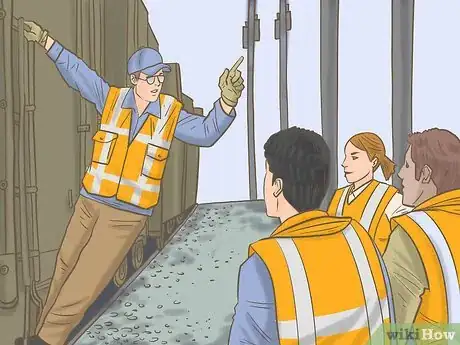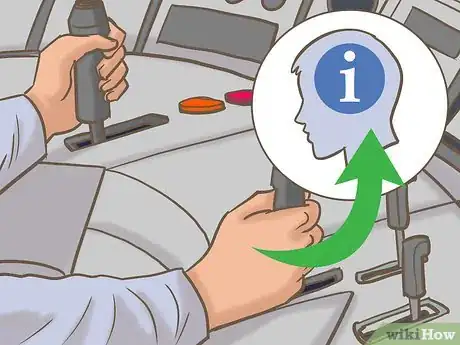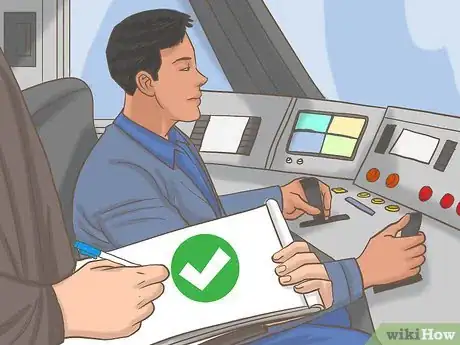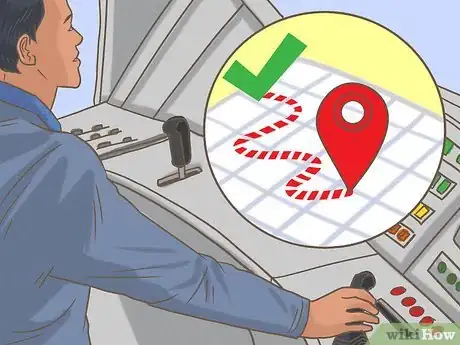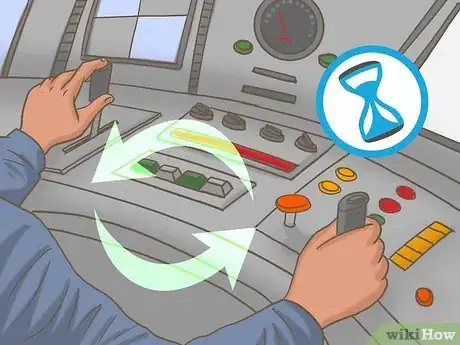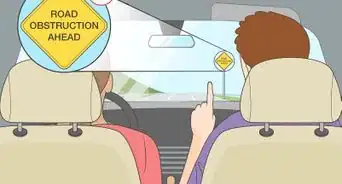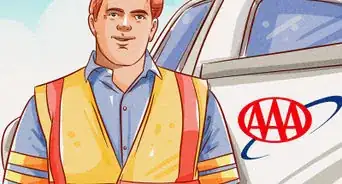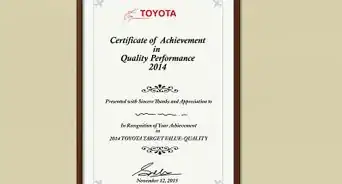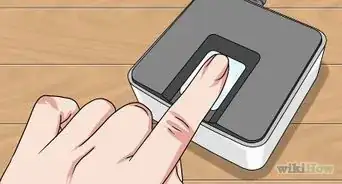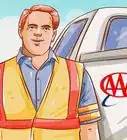This article was co-authored by wikiHow Staff. Our trained team of editors and researchers validate articles for accuracy and comprehensiveness. wikiHow's Content Management Team carefully monitors the work from our editorial staff to ensure that each article is backed by trusted research and meets our high quality standards.
There are 14 references cited in this article, which can be found at the bottom of the page.
wikiHow marks an article as reader-approved once it receives enough positive feedback. This article received 18 testimonials and 80% of readers who voted found it helpful, earning it our reader-approved status.
This article has been viewed 394,691 times.
Learn more...
A train driver operates, or drives, a train. They're also called locomotive engineers, railroad engineers or foot plate men. It's a job that offers a variety of options, whether you want to stay close to home and work for a local railroad or you prefer to travel further afield with a regional railroad. It pays well and affords you the benefits of belonging to a union, such as job security and a pension.
Steps
Getting the Education and Training You Need
-
1Get your high school diploma or GED. For most entry-level railroad jobs, you must be at least 18 years of age and have a high school diploma or equivalent. Completing high school will provide you with the basic educational background and life experience necessary for working in the railroad.[1]
-
2Attend a locomotive engineer training program. All entry-level railroad positions require training to learn the basics of railroad work. Many community and state colleges offer courses and even associates degrees in railroad operations and locomotive engineering. You can also find directories online that can help you locate a training center or program near you.[3] .
- Look for training programs that are often run in partnership with small regional or local railroads. In addition to providing you with the training you need, these can be helpful for connecting you to job opportunities in your area.
Advertisement -
3Apply for beginner-level positions with a railroad. Many locomotive engineers start out as conductors, rail yard engineers, switch operators or yardmasters, where they learn about the policies, operations and routes of the railroad before moving into training to become a driver. Getting your foot in the door in a starter position will give you a chance to build familiarity with railroad work while earning a living.[4]
- Applications are online through railroad websites by following links for job and career opportunities.
- Check out a variety of railroad jobs online on forums like the one hosted by RailServe.com.[5]
- If you want to drive commuter trains or subway trains, check for jobs with area public transit authorities.[6]
- Job fairs at community colleges and local universities with railroad training programs also host railroad companies.
Working in Entry-Level Positions
-
1Work your way up to a train driver position. Beyond age, education and physical ability, railroads look for drivers who possess strong leadership, decision making, and organizational skills, among other things, including:[7]
- Familiarity and experience with machinery is a plus.
- Show basic literacy in reading, math, and simple computing.
- Work well independently and with others.
- Ability to learn and adhere to procedures and guidelines.[8]
-
2Apply for a training position if you are 21 years or older. You must meet the minimum age requirements to apply for a locomotive engineering position (21 years) and have the right educational background (high school diploma or equivalent). Look for job postings online on railroad websites and job forums. The same sites that post entry-level positions post locomotive engineering positions, too.[9]
- Train drivers must pass hearing and vision tests, demonstrate physical ability, and go through periodic drug screenings.[10]
-
3Complete the required training. During the training period you will learn all the procedures, operations and route details you will need to operate the train. Training will involve a combination of classroom and hands-on exercises, including working with train simulators and, eventually, real trains.[11]
- Some railroads may have onsite training or they may partner with a college or University in the area. Others will require you to go offsite to a centralized training facility for up to 2 months or more.
- Amtrak, for example, requires it’s trainee locomotive engineers to spend 8-10 weeks at their training center in Wilmington, DE before they begin their on-the-job training.[12]
- Training will include preparing you for certification, which includes memorizing all the physical aspects of the train routes on which you will drive.[13]
Getting and Staying Certified
-
1Take a written knowledge test. The Federal Railroad Administration requires each railroad company to oversee its own certification process. The written test is the first part of the certification process and is based on studying each railroad’s operating practices, equipment inspection procedures, train route knowledge and Federal safety regulations.[14] There are three levels of certification that you can test for based on your experience and job specifications: student engineer, locomotive servicing engineer and train service engineer.[15]
- Train service engineers are the most skilled and experienced. They may drive locomotives with cars attached.
- Locomotive servicing engineers may operate trains but cannot drive them with cars attached.
- Student engineers may only operate trains while under the direct supervision of an instructor.
-
2Take a skills test.[16] Like the written test, the skills test evaluates your knowledge of operating practices, equipment inspection procedures, train route knowledge and Federal safety regulations.[17]
- You must demonstrate your ability to put your knowledge into practice while you are behind the controls of a train or a train simulator.
- If you fail the skills test, the Federal Railroad Administration does allow a retest.[18]
-
3Demonstrate a mastery of your assigned route. In addition to the standard written and skills test that all locomotive engineers must take, the Federal Railroad Administration requires that candidates for certification are fluent in the physical aspects of their specific assigned route.[19]
- It is up to each railroad company to determine the details of how they assess this knowledge, but the use of train simulators are common.[20]
-
4Complete continuing education and training. Once you work for a railroad company the Federal Railroad Administration requires them to periodically retest you.[21]
- Additional training periods are also required whenever you are assigned to a new train route to ensure that you know the route inside and out.
Community Q&A
-
QuestionHow old do I have to be in order to be a train driver?
 Community AnswerYou must be 18 years of age or older. If you are you are under the age you could try volunteering at your local railroad museum to learn the ropes.
Community AnswerYou must be 18 years of age or older. If you are you are under the age you could try volunteering at your local railroad museum to learn the ropes. -
QuestionCan females be train drivers?
 Community AnswerAbsolutely, anyone who meets the qualifications may apply.
Community AnswerAbsolutely, anyone who meets the qualifications may apply. -
QuestionIs it possible for someone in their thirties to become a train driver or a conductor?
 Community AnswerYes. As long as you can make it through the training and understand the requirements of the job, you should be fine.
Community AnswerYes. As long as you can make it through the training and understand the requirements of the job, you should be fine.
Warnings
- Train drivers are required to work long, irregular hours, including nights, weekends and holidays. They are often required to put their names on a list and wait to be assigned work, which means being ready to work on short notice. They may have to work in severe weather conditions, which means not only working outside in the cold and heat, but sitting in cold or hot train cars.[23]⧼thumbs_response⧽
References
- ↑ https://www.bls.gov/ooh/transportation-and-material-moving/railroad-occupations.htm#tab-4
- ↑ https://study.com/articles/A_High_School_Diploma_v_the_GED.html
- ↑ https://www.railserve.com/Training_Programs/
- ↑ https://www.jobhero.com/how-to-become-train-driver
- ↑ https://www.railserve.com/Railroad_Employment_Jobs
- ↑ https://www.bls.gov/ooh/transportation-and-material-moving/railroad-occupations.htm#tab-4
- ↑ https://learn.org/articles/How_Do_I_Become_a_Locomotive_Engineer.html
- ↑ http://www.narstraining.com/things-you-should-know-before-you-go
- ↑ https://www.bls.gov/ooh/transportation-and-material-moving/railroad-occupations.htm#tab-4
- ↑ https://www.jobhero.com/how-to-become-train-driver
- ↑ https://www.federalregister.gov/documents/2008/12/31/E8-31062/qualification-and-certification-of-locomotive-engineers-miscellaneous-revisions
- ↑ https://jobs.amtrak.com/go/Locomotive-Engineer-Jobs/400414/
- ↑ https://www.federalregister.gov/documents/2008/12/31/E8-31062/qualification-and-certification-of-locomotive-engineers-miscellaneous-revisions
- ↑ https://www.govinfo.gov/content/pkg/CFR-2016-title49-vol4/xml/CFR-2016-title49-vol4-part240.xml#seqnum240.211
- ↑ https://www.federalregister.gov/documents/2008/12/31/E8-31062/qualification-and-certification-of-locomotive-engineers-miscellaneous-revisions
- ↑ http://www.pta.wa.gov.au/careers/train-driver-recruitment#Aptitude-tests-135
- ↑ https://www.govinfo.gov/content/pkg/CFR-2016-title49-vol4/xml/CFR-2016-title49-vol4-part240.xml#seqnum240.211
- ↑ https://www.federalregister.gov/documents/2008/12/31/E8-31062/qualification-and-certification-of-locomotive-engineers-miscellaneous-revisions
- ↑ https://www.bls.gov/ooh/transportation-and-material-moving/railroad-occupations.htm#tab-4
- ↑ https://www.federalregister.gov/documents/2008/12/31/E8-31062/qualification-and-certification-of-locomotive-engineers-miscellaneous-revisions
- ↑ https://www.federalregister.gov/documents/2008/12/31/E8-31062/qualification-and-certification-of-locomotive-engineers-miscellaneous-revisions
- ↑ https://www.bls.gov/ooh/transportation-and-material-moving/railroad-occupations.htm#tab-6
- ↑ https://www.bls.gov/ooh/transportation-and-material-moving/railroad-occupations.htm#tab-3
About This Article
To become a train driver, get a high school diploma or GED and enroll in a locomotive engineer training program to learn the basics of railroad work. Next, apply for an entry-level position with a railroad so you can gain experience in the field and get your foot in the door with a good company. Then, you can apply for a training position as long as you're at least 21 years old. After you complete the training program, take the exams required to get certification and start looking for open positions! To learn more about the certification exams, read on!

